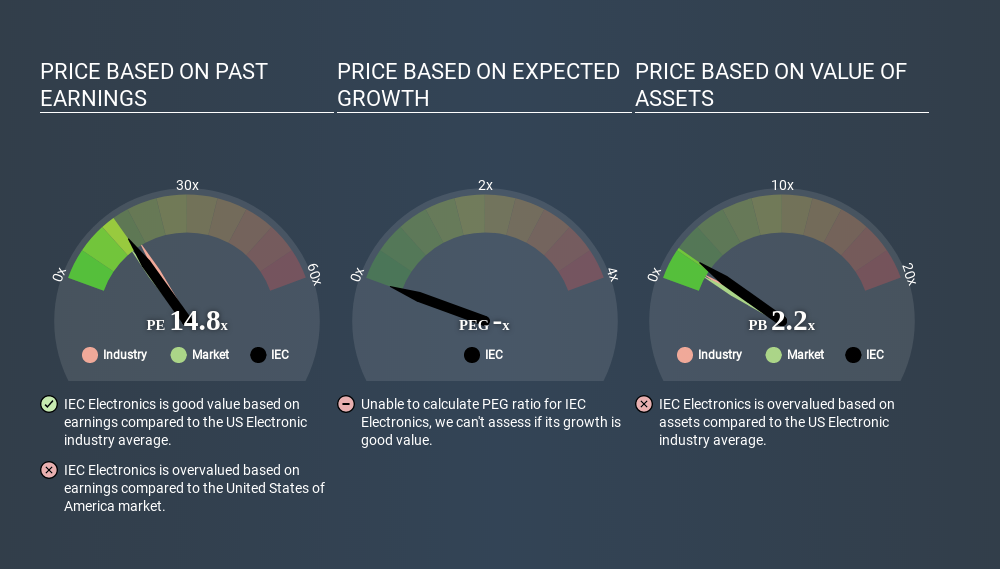
Those holding IEC Electronics (NASDAQ:IEC) shares must be pleased that the share price has rebounded 37% in the last thirty days. But unfortunately, the stock is still down by 26% over a quarter. Unfortunately, the full year gain of 3.3% wasn't so sweet.
Assuming no other changes, a sharply higher share price makes a stock less attractive to potential buyers. In the long term, share prices tend to follow earnings per share, but in the short term prices bounce around in response to short term factors (which are not always obvious). So some would prefer to hold off buying when there is a lot of optimism towards a stock. One way to gauge market expectations of a stock is to look at its Price to Earnings Ratio (PE Ratio). A high P/E implies that investors have high expectations of what a company can achieve compared to a company with a low P/E ratio.
Check out our latest analysis for IEC Electronics
How Does IEC Electronics's P/E Ratio Compare To Its Peers?
We can tell from its P/E ratio of 14.79 that sentiment around IEC Electronics isn't particularly high. We can see in the image below that the average P/E (16.7) for companies in the electronic industry is higher than IEC Electronics's P/E.

IEC Electronics's P/E tells us that market participants think it will not fare as well as its peers in the same industry. Since the market seems unimpressed with IEC Electronics, it's quite possible it could surprise on the upside. It is arguably worth checking if insiders are buying shares, because that might imply they believe the stock is undervalued.
How Growth Rates Impact P/E Ratios
Earnings growth rates have a big influence on P/E ratios. When earnings grow, the 'E' increases, over time. That means unless the share price increases, the P/E will reduce in a few years. A lower P/E should indicate the stock is cheap relative to others -- and that may attract buyers.
IEC Electronics's earnings per share fell by 60% in the last twelve months. But it has grown its earnings per share by 26% per year over the last three years.
Remember: P/E Ratios Don't Consider The Balance Sheet
The 'Price' in P/E reflects the market capitalization of the company. In other words, it does not consider any debt or cash that the company may have on the balance sheet. In theory, a company can lower its future P/E ratio by using cash or debt to invest in growth.
Such spending might be good or bad, overall, but the key point here is that you need to look at debt to understand the P/E ratio in context.
So What Does IEC Electronics's Balance Sheet Tell Us?
Net debt is 39% of IEC Electronics's market cap. While that's enough to warrant consideration, it doesn't really concern us.
The Verdict On IEC Electronics's P/E Ratio
IEC Electronics's P/E is 14.8 which is above average (13.7) in its market. With some debt but no EPS growth last year, the market has high expectations of future profits. What we know for sure is that investors have become more excited about IEC Electronics recently, since they have pushed its P/E ratio from 10.8 to 14.8 over the last month. For those who prefer to invest with the flow of momentum, that might mean it's time to put the stock on a watchlist, or research it. But the contrarian may see it as a missed opportunity.
When the market is wrong about a stock, it gives savvy investors an opportunity. As value investor Benjamin Graham famously said, 'In the short run, the market is a voting machine but in the long run, it is a weighing machine. We don't have analyst forecasts, but shareholders might want to examine this detailed historical graph of earnings, revenue and cash flow.
Of course you might be able to find a better stock than IEC Electronics. So you may wish to see this free collection of other companies that have grown earnings strongly.
If you spot an error that warrants correction, please contact the editor at editorial-team@simplywallst.com. This article by Simply Wall St is general in nature. It does not constitute a recommendation to buy or sell any stock, and does not take account of your objectives, or your financial situation. Simply Wall St has no position in the stocks mentioned.
We aim to bring you long-term focused research analysis driven by fundamental data. Note that our analysis may not factor in the latest price-sensitive company announcements or qualitative material. Thank you for reading.
Market Insights
Community Narratives



